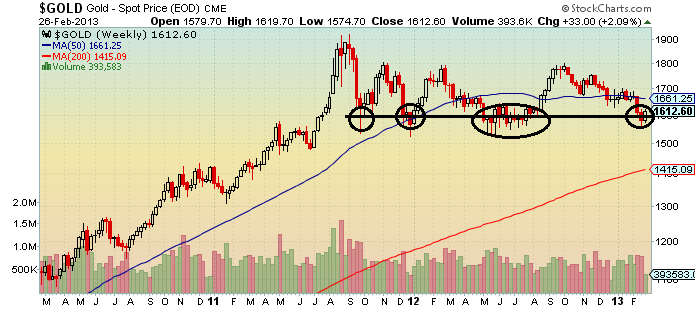Gold prices may have fallen in the short-term, but this bull market is far from over
Only a week ago, the price of gold plunged below $1600 due to the US Federal Reserve’s Federal Open Market Committee minutes from its latest meeting at the end of January. Although prices began to slip ahead of the release of the minutes, the selling accelerated after the minutes hinted that the Fed could possibly end its QE3 debt-monetization campaign sooner rather than later.
Yesterday the price of gold soared by nearly 2% in the biggest one-day percentage gain since 6 November, 2012. The gold price reacted to comments made by the U.S. Federal Reserve chairman Bernanke in a Senate hearing. The Fed Chairman reaffirmed that his $85 billion bond purchases supported economic recovery and job creation, with benefits outweighing the costs from excessive risk-taking in some sectors. “To this point we do not see the potential costs of the increased risk-taking in some financial markets as outweighing the benefits of promoting a stronger economic recovery and more-rapid job creation.”
Bernanke’s statement implied that that Fed is going to continue with its easy money policy which is bullish for gold. Also, there were signs of safe-haven buying as fresh concerns about the sovereign debt crisis in the Eurozone have re-emerged due the impasse of the Italian elections. The Democratic Party leader Bersani took 340 seats in the 630 seat-lower house but fell short of a majority in the upper house, taking just 113 seats out of 315. Former prime-minister Berlusconi took 116 seats in the Senate. A majority in both houses is needed for the government and the current situation could lead to a stalemate which in turn could lead to months of uncertainty.
As the price of gold fell below the $1600 an ounce level last week, it came under pressure from heavy liquidation by hedge funds, banks, short sellers, technical and momentum traders which in turn caused some nervous longs to be stopped out through stop loss orders. And, when the price of the yellow metal breached a series of major support levels, gold market sentiment turned the most negative that we have seen in recent years. The ratio of sell orders to buy orders was the highest it has ever been in recent days. And, as the price looked set to hit $1550 an ounce, many retail buyers who are very nervous about the outlook for gold and concerned about the risk of further price falls, lost their nerve and sold.
As usual, most of the selling occurred on Comex as traders were able to drive prices down using their gold futures contracts. And, much of the selling was related to chart weakness. There is a huge dislocation between the physical market of gold and the paper market for gold. But, unfortunately, at the moment, it seems that speculative trades are determining the trend, much like the tail wagging the dog.
While, prices of gold have plunged in the short-term, and as I have stated countless times, these sharp price declines do not reflect the real fundamentals which include a European and coming UK, U.S. and Japanese debt crises’, global currency wars and the real risk of recessions and a depression.
Furthermore, the US Fed is not going to stop with its easy money policy and if and when they do, you can be rest assured that interest rates and inflation will be much higher than they are now.
Since 2008, when President Obama was elected, the official net public debt of the US federal government has increased by $5.5 trillion. That is more than double the size of the total net public debt of the US in 2007 when it was ($5.0) trillion. The total net debt of the US government has exploded to more than $11 trillion, or roughly 80% of GDP.
In the meantime, The Fed has more than tripled the size of its balance sheet since 2008 to around $3 trillion through a series of bond buying programs and it opted in January to keep purchasing assets at an $85 billion monthly pace until the labour market outlook improved substantially.
Despite the trillions in bail outs and stimulus programmes, the U.S. economy still appears stagnant and the unemployment rate remains close to 8%.
And, despite growing confidence that Europe is managing its debt crisis and is poised to embark on a recovery, fresh developments indicate that the region continues to struggle to stimulate growth while cutting spending to pare deficits.
According to a top European official, Eurozone economy is likely to shrink for the second consecutive year and that countries like France and Spain will miss fiscal targets meant to ensure the stability of the common currency.
The economic doldrums could set the stage for ripple effects for the United States, particularly in the financial markets.
Olli Rehn, the European commissioner for economic and monetary affairs, forecast growth across the 27 nation European Union of just 0.1% this year and a contraction of 0.3% among the 17 countries in the euro zone.
In another sign of continued weakness in the financial system, European banks plan to repay less than half the expected amount of low-interest loans they took from the European Central Bank.
The central bank lent more than 1 trillion euros ($1.33 trillion) in two operations in December 2011 and February 2012. The cheap loans provided a life raft for the region’s banking sector, which ran into difficulty during the debt crisis. During the period of uncertainty, banks refused to lend to one another. Late last month, banks paid back 137 billion euros of the loans, more than expected, suggesting that at least some banks were able to raise money on their own.
But on Friday, the central bank said that banks that took the second round of loans planned to return 61 billion euros in the latest repayment, much less than many had expected.
In Spain, the commission said it expected unemployment to hit 26.9% up from 25% last year. In Greece, the forecast was for unemployment to leap to 27 % from 24.7% a year earlier.
Even in Germany, which is expected to grow this year by 0.5%, unemployment was seen nudging up slightly this year, to 5.7% from 5.5% in 2012.
While the mainstream media is reporting an economic turnaround, I am not convinced. And, as Federal Reserve Chairman Ben Bernanke is trying to create the illusion of wealth by pumping money into the system, the average US citizen is having a tougher and tougher time as the cost of living is higher relative to their salaries. Furthermore, the economy is not growing and unemployment remains elevated.
The misguided perception that things are improving may induce some people to liquidate their gold holdings, but the prudent investor who is able to read between the lines, understands this current price drop does not alter the long-term picture and will simply continue to accumulate more gold and silver.
Technical Analysis
Since October 2011, this is the fourth time that the price of gold has breached the support level of $1600/oz. In each of the previous breaks, the price has soon recovered. I expect this to happen again.
***
David Levenstein is a leading expert on investing in precious metals . Although he began trading silver through the LME in 1980, over the years he has dealt with gold, silver, platinum and palladium. He has traded and invested in bullion, bullion coins, mining shares, exchange traded funds, as well as futures for his personal account as well as for clients.
His articles and commentaries on precious metals have been published in dozens of newspapers, publications and websites both locally as well as internationally. He has been a featured guest on numerous radio and TV shows, and is a regular guest on JSE Direct, a premier radio business channel in South Africa. The largest gold refinery in the world use his daily and weekly commentaries on gold.
David has lived and worked in Johannesburg, Los Angeles, London, Hong Kong, Bangkok, and Bali.
For more information go to: www.lakeshoretrading.co.za
Information contained herein has been obtained from sources believed to be reliable, but there is no guarantee as to completeness or accuracy. Any opinions expressed herein are statements of our judgment as of this date and are subject to change without notice.
{{ commodity.name }}
{{ post.title }}
{{ post.date }}


Comments